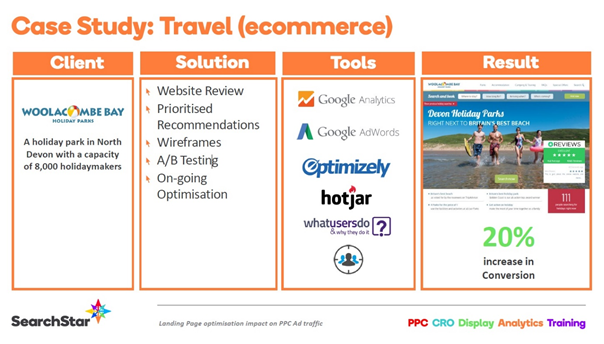
When it comes to business, we are always told how important it is to make a great first impression; ‘stand up straight’ ‘smile’ ‘strong handshake’ ‘eye contact’ you’ve heard it all but are you translating that to your website?
According to Google research, it takes just 50 milliseconds to form an opinion and just 5 – 8 seconds to capture attention. Think of that and take a look at your website, is your home page making a lasting first impression?
At SearchStar, we have a systematic approach to critiquing websites that means we regularly see our clients receiving a 20-40% conversion rate increase. I’d like to share some of this approach with you so you can start to apply the insight to your own business and think objectively about what you might be able to do to make your website work harder.
Firstly, look at your website from the customer’s point of view. That means going right back to basics and searching Google. Think what words your customers will be searching to find you, what else comes up in the search, who else is advertising?
Now open your website with fresh eyes and work through the following key points. You can download our unique landing page scorecard, which will help you look at the six key areas. Make sure you answer the questions as honestly as you can, ‘kind of’ or ‘a little bit’ are just different ways of saying no.
Remember, walk in the shoes of your customer. As far as possible, be objective and try to empathise - take the position of your customer or prospect when you’re filling this scorecard out. The more impartial you can be at this stage, the better your results will be.
Start with your home page and work through the following:
Relevance - Does the page match user intent?
The user’s journey started before they got to your page. They found you from a PPC ad, an email newsletter, Facebook ad or a referral from a friend. Before that, they were dreaming about their next holiday/cat litter tray/ppc agency, making decisions long before they got to you. Make sure the immediate message on the landing page helps to join this journey up.
Simplicity – Does the user know what to do once they get to your page?
First impressions are good. Your page seems to match their search and your site could be the one to sell them the cat litter tray of their dreams. In your least patronising voice, don’t make the visitor think too much, don’t hide key buttons or information and make sure it is clear what you want them to do next.
USPs – Why should they choose you?
In any market there’s competition. Your users need to know what the advantage is (to them) of buying through you. Is it free delivery, cheaper prices, award-winning service or that you’re local? Whatever your differentiators are, make sure you shout about them.
Clutter – What’s the key message?
Within two seconds of landing on your page, is it clear what the visitor should do next? Are visitors blinded by mega-menus or HUGE buttons trying to take them to different areas of the site or is the primary call to action hidden away at the bottom of the page (or written in teeny, tiny letters).
Reassurance – Am I safe?
Has anyone in the world used your services or bought from you before? How can you show prospective customers that you’re real, reliable and good! Reassurance comes in many forms, local or industry awards, online reviews from real customers through Trustpilot or Reviews.co.uk, engagement on a social media channel that’s appropriate for your brand – anything that publically tells prospects you’re good.
Deadline – Why should I do this today?
You want people to buy from you today, not work to their own schedule. Depending on the type of site and the commodity you’re selling, urgency can be created by offering discounts; showing reduced stock levels or showing when offers expire. Out of the six categories, this is possibly the least important (by a whisper), and often not as relevant in B2B. That doesn't mean you shouldn't test ideas here though.
Here's a great example of a how we used this method to re-design a client’s home page:
Hopefully, this exercise has helped you to identify the key areas to work on and understand where you need to focus your efforts in order to make that great first impression.
And don’t forget, the real fun starts when you A/B test the new version of the page to see if the results are a winner!
- Log in to post comments
Join SearchStar at their digital advertising conference!
You can hear more from Ryan Webb and other great speakers from the likes of Google and Facebook at SearchStar’s one-day digital advertising conference at Apex Hotel, Bath on Thursday November 9th.

